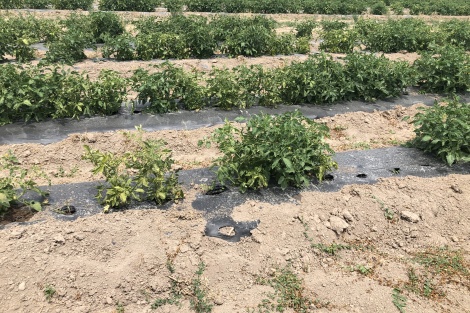In this Issue:
- Earwigs: Wreaking havoc in cucurbits
- Root Rot: Affecting squash
- Sunscald on Peas: Too much sun exposure
- Curly Top Virus: Spread by beet leafhoppers
Earwigs (Forficula auricularia) damaging cucurbits
Overview
There have been incidences of earwigs (Forficula auricularia) inflicting damage on cantaloupe and other cucurbit species on commercial farm sites within Salt Lake County. Earwig eggs measure about 1mm and are elliptical and white. The nymphs develop through four stages. The adults can measure 13-14 mm and are a dark brown to maroon color. They have two long antennae and notable cerci pinchers at the tip of their abdomen.
Damage
Both earwig nymphs and adults will crawl into tight, dark places during the day. Earwigs consume foliage which leaves it skeletonized.
Management
– Monitor populations by using traps or bait (most effectively applied in the evening).
– Commercial products are rarely formulated for earwigs as they rarely cause severe damage.
Additional Resources
How to trap earwigs (Video)
European Earwig (USU Factsheet)
Earwigs (Maryland Extension)
Root Rot on Squashes
Overview
With the increase in temperatures along with wet soil, there has been a sporadic occurrence of Phytophthora spp. throughout northern Utah amongst various squash species. There are several potential soil-borne pathogens in the genus Phytophthora that can cause root rot. Symptoms in squashes can cause yellowing of the foliage, wilting, and plant death. Phytophthora organisms thrive, grow, reproduce, and infect plant roots in water or saturated soil.
Management
Squashes can be at risk for root rot throughout the entire growing season. It is critical to identify symptoms early on.
– Provide good soil drainage and water management to prevent standing water.
– Rotate crops throughout the season.
– Avoid planting susceptible crops in soil known to be infected with Phytophthora.
– Use resistant varieties when available.
Additional Resources
Phytophthora disease reported on winter squash and pumpkin (Michigan State Extension)
Phytopthora Blight of Cucurbits (Cornell-New York Extension)
Phytopthora Blight (Massachusetts Extension)
Sunscald on Peas

Overview
When harvesting peas you might notice some “disease looking” coloration or spotting on the peapod. this damage is likely attributed to sun exposure. Most pea plants a cool-season crop that needs to mature before the heat of summer hits.
Management
Most garden peas are ready to harvest usually 8-21 days after harvesting. Harvest when pods are full-size with small seeds. They should also have small seeds and crisp flesh when being picked.
Avoid leaving harvested peas out in the sun for too long.
Additional Resources
Pea Production (USU Extension)
How to plant peas (USU Extension)
Peas in the Garden (USU Fact Sheet)
Curly Top Virus
Overview
Curly top virus is a curtovirus that is spread by the beet leafhopper (Circulifer tenellus). This disease is widespread across Utah and has been reported at various tomato farms throughout the state. The symptoms include small, twisted, curled leaves with purple veins and the yellowing and death of mature leaves.
Beet leafhoppers acquire the virus when feeding on infected weeds or other plants and transmit it when feeding on healthy plants. The virus can overwinter in living host plants and the beet leafhopper.
Management
– Begin watching for symptoms in the spring.
– Shade plants
– Remove infected plants immediately upon detection.
– Exclude leafhoppers with floating row covers.
– There are no chemical control options for curly top virus and insecticide applications directed at beet leafhopper are ineffective.
Additional Resources
Curly Top Virus (New Mexico State University)
Curly Top Virus (USU Fact Sheet)
Curly Top Virus (Oklahoma State Extension)








